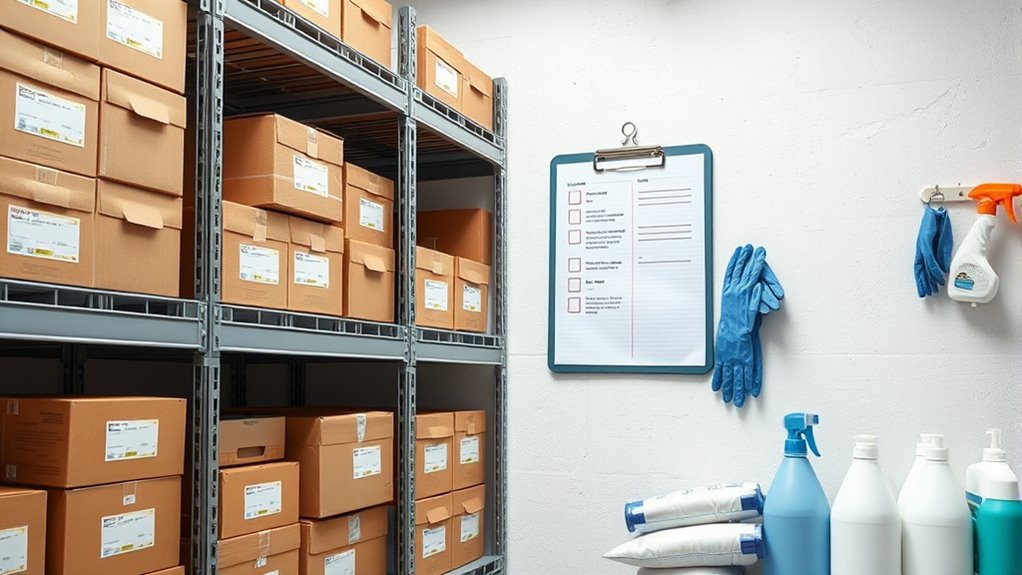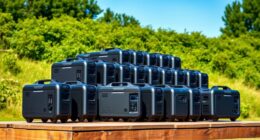To maintain your long-term storage effectively, focus on proper packing by wrapping fragile items with bubble wrap, using sturdy boxes, and labeling everything clearly. Keep the environment cool, dry, and well-ventilated while avoiding damp areas like basements or attics. Regularly inspect climate controls, check for pests, and monitor stored items for damage. Proper organization and routine maintenance help preserve your belongings—continue exploring to guarantee you’re doing everything right.
Key Takeaways
- Do regularly inspect climate control and pest prevention systems; avoid neglecting maintenance to prevent damage.
- Do label and organize stored items clearly; avoid stacking randomly to reduce risk of breakage or difficulty locating items.
- Do fill empty spaces with packing materials; avoid leaving gaps that allow shifting or pest entry.
- Do keep storage areas clean, dry, and well-ventilated; avoid damp or poorly ventilated spaces that accelerate deterioration.
- Do conduct periodic inspections for pests, mold, and damage; avoid ignoring early warning signs to prevent long-term issues.
Proper Packing and Labeling Techniques
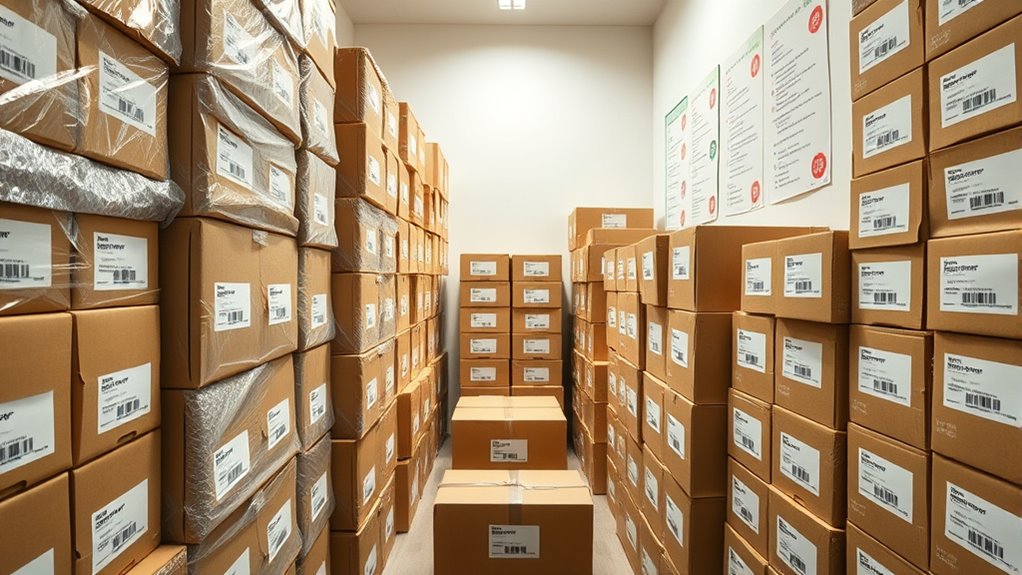
To guarantee your stored items remain in good condition over the long term, it’s essential to use proper packing and labeling techniques. When packing fragile items, wrap them with bubble wrap or packing paper, and place them in sturdy boxes to prevent breakage. Use dividers or padding to keep items from shifting. Proper labeling is equally important; mark boxes with “Fragile” and specify their contents to avoid mishandling. Additionally, think about space optimization by stacking boxes carefully and filling empty spaces with packing materials to prevent movement. Labeling each box clearly helps you locate items easily later, reducing unnecessary handling. Following these techniques ensures your items stay safe, organized, and accessible, making your long-term storage efficient and stress-free.
Ideal Storage Environment Conditions
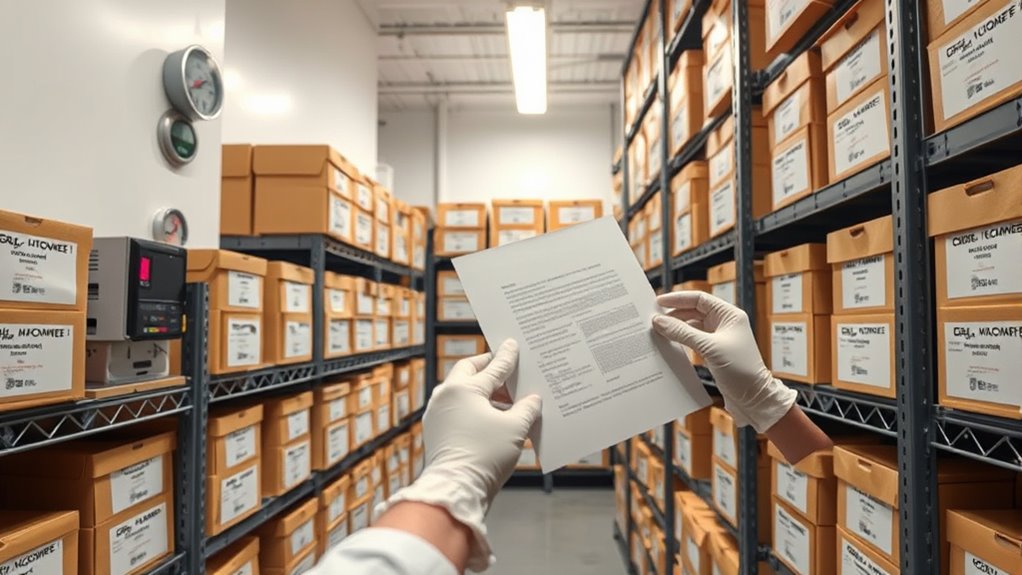
Maintaining the right storage environment is essential for preserving your items over the long term. You should aim for consistent climate control to prevent extreme temperature fluctuations and high humidity, which can cause damage or deterioration. Keep your storage area cool, dry, and well-ventilated to slow down aging and mold growth. Pest prevention is equally important; use sealed containers, pest traps, and regular cleaning to keep insects and rodents at bay. Avoid storing items in basements or attics prone to dampness or temperature swings. Proper airflow and stable conditions minimize environmental stress on your belongings. By controlling climate and preventing pests, you’ll considerably extend the lifespan of your stored items, ensuring they remain in good condition for years to come. Proper storage practices also include regular inspections to catch potential issues early.
Regular Inspection and Maintenance Practices
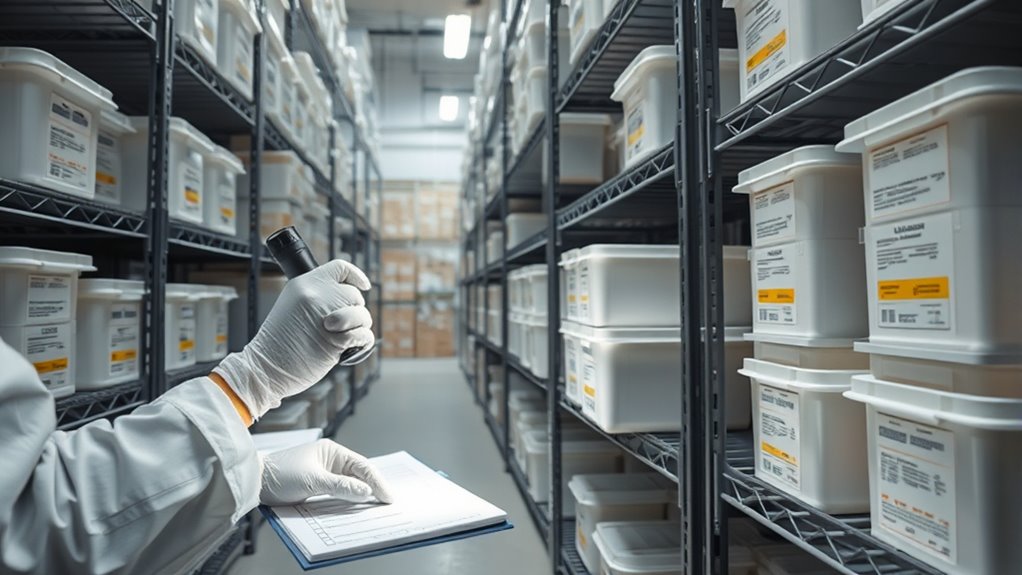
Regular inspection and maintenance are essential for catching potential issues early and ensuring your storage remains in ideal condition. You should regularly check climate control systems to maintain consistent temperature and humidity levels, preventing damage caused by fluctuations. Look for signs of pests, such as droppings, holes, or chewed packaging, and address any infestations immediately to prevent widespread damage. Keep an eye on stored items for signs of deterioration, mold, or pests. Clean storage areas regularly to reduce dust, debris, and pest attractants. Seal any cracks or openings that pests could use to enter. Maintaining these practices helps preserve your items’ integrity, reduces long-term repair costs, and keeps your storage environment safe and secure. Additionally, regular vehicle tuning practices can help ensure your stored vehicles remain in good condition, especially if they are used infrequently.
Frequently Asked Questions
How Long Can Items Be Stored Without Degrading?
You can store items for years if you maintain proper climate control and choose the right container. Keep temperatures stable and avoid humidity to prevent degradation. Using airtight, sturdy containers protects against pests and moisture, extending storage life. Regularly check your stored items, and adjust climate control as needed. With these practices, you can appreciably prolong the quality of your stored belongings, ensuring they stay in good condition for years to come.
What Are Common Pests That Threaten Stored Items?
Rodents, silverfish, and cockroaches are common pests that threaten stored items. It’s essential to investigate the truth that pests can invade even well-sealed storage spaces. You should focus on rodent prevention by sealing gaps and removing food sources. Regular pest inspection helps catch infestations early. By staying vigilant and maintaining these practices, you protect your belongings from damage and contamination.
Are There Specific Materials Best for Long-Term Storage?
For long-term storage, choose materials like acid-free boxes and archival-quality packing supplies to protect your items. You should also guarantee proper climate control, maintaining consistent temperature and humidity levels to prevent damage. Avoid using paper or cardboard that can attract pests or cause deterioration. Opt for plastic containers with tight-fitting lids for added protection. By combining suitable packing materials with climate control, you keep your stored belongings safe and preserved over time.
How Do I Handle Sensitive Electronic Equipment?
You should handle sensitive electronic equipment by creating digital backups to protect your data. Store the equipment in a cool, dry place with proper moisture control to prevent corrosion and damage. Avoid exposure to extreme temperatures and humidity. Regularly check the condition of your electronics, and consider using anti-static bags for added protection. These steps guarantee your equipment remains functional and data stays safe during long-term storage.
What Are Signs of Storage Environment Failure?
Your storage environment whispers warnings when climate control falters—humidity rises like a brewing storm, causing corrosion or mold. Structural integrity may weaken, with cracks or sagging indicating unseen damage. Keep an eye out for rust, warping, or unusual odors, which signal failure. Staying vigilant guarantees your items stay safe, like a sturdy ship weathering a storm, by maintaining ideal conditions and checking for signs of deterioration regularly.
Conclusion
By mastering proper packing and labeling, maintaining ideal storage conditions, and committing to regular inspections, you guarantee your items stay protected and preserved over the long term. Prioritize organization, monitor environmental factors, and stay proactive with maintenance. Keep your storage space clean, your items well-protected, and your inspections consistent. In doing so, you’ll prevent damage, prolong the lifespan of your belongings, and enjoy peace of mind, knowing your long-term storage is truly secure and well-maintained.
